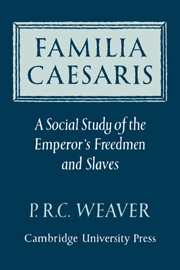Book contents
- Frontmatter
- Contents
- Preface
- Abbreviations
- INTRODUCTION
- PART I NOMENCLATURE AND CHRONOLOGY
- PART II THE FAMILY CIRCLE
- PART III THE EMPEROR'S SERVICE
- 12 Vicarii
- 13 Liberti servus and liberti libertus
- 14 ‘Vicariani’
- 15 The occupational hierarchy: some points of method
- 16 Sub-clerical grades
- 17 Adiutores: junior clerical grades
- 18 Intermediate clerical grades
- 19 Senior clerical grades
- 20 Senior administrative grades: a rationibus, ab epistulis, etc.
- 21 Freedman procurators
- 22 Imperial freedmen and equestrian status: the father of Claudius Etruscus
- CONCLUSION
- APPENDIXES
- Bibliography
- Index
15 - The occupational hierarchy: some points of method
Published online by Cambridge University Press: 07 October 2011
- Frontmatter
- Contents
- Preface
- Abbreviations
- INTRODUCTION
- PART I NOMENCLATURE AND CHRONOLOGY
- PART II THE FAMILY CIRCLE
- PART III THE EMPEROR'S SERVICE
- 12 Vicarii
- 13 Liberti servus and liberti libertus
- 14 ‘Vicariani’
- 15 The occupational hierarchy: some points of method
- 16 Sub-clerical grades
- 17 Adiutores: junior clerical grades
- 18 Intermediate clerical grades
- 19 Senior clerical grades
- 20 Senior administrative grades: a rationibus, ab epistulis, etc.
- 21 Freedman procurators
- 22 Imperial freedmen and equestrian status: the father of Claudius Etruscus
- CONCLUSION
- APPENDIXES
- Bibliography
- Index
Summary
It is now necessary to consider more closely the hierarchy and the system of promotion in the sub-equestrian regions of the Imperial administration. No bureaucracy can function efficiently without order and opportunity in its lower as well as its higher ranks. It is necessary to affirm this of the lower ranks of the Roman bureaucracy in the early Empire precisely because it has so often been denied or ignored. The impression gained from reading many works on the Imperial administration is that of fervid equestrian movement from post to post and province to province at the top, with a static substratum of Imperial slaves and freedmen providing stability and continuity below. Such an account is to some extent true. But that it is not true enough emerges from a detailed consideration of the inscriptional evidence.
To begin with, two general points of method in the use of the inscriptions need to be made, as they are fundamental to any reconstruction of the slave and freedman hierarchy.
In the first place, there is a difference between the manner of recording an equestrian career, where all the posts from that of, say, praefectus cohortis, held in the twenties, are recorded, and a freedman career, where in the clerical and sub-clerical grades only the highest post actually reached by the end of a career (e.g. tabularius, a commentariis, dispensator) is recorded. This is not to be interpreted as meaning that the slaves and freedmen spent their lives in a single post on a single grade.
- Type
- Chapter
- Information
- Familia CaesarisA Social Study of the Emperor's Freedmen and Slaves, pp. 224 - 226Publisher: Cambridge University PressPrint publication year: 1972
- 1
- Cited by



